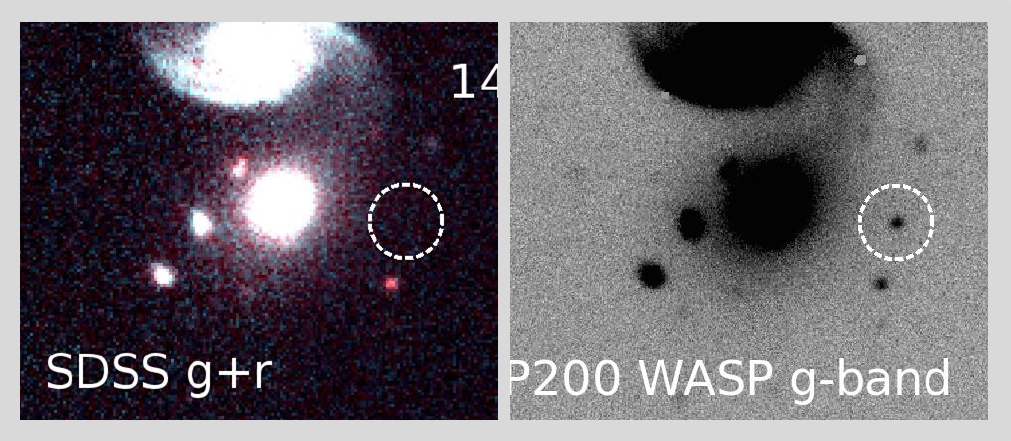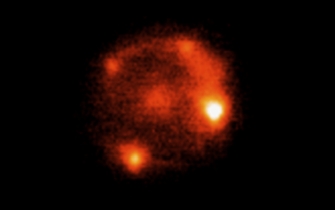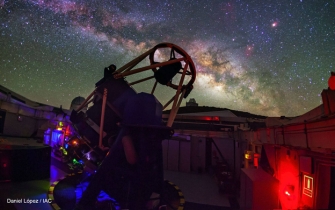
The left panel is an archival SDSS image of the region where the peculiar supernova ZTF 18aaqeasu was found. The right panel shows an image taken with the 200-inch telescope at the Palomar Observatory on which the supernova is visible.
2019
7 FebAstronomers find clues to the origins of exploding dead stars
Dying stars known as Type Ia supernovae are often referred to as standard candles because they all emit the same, well-known amount of light when they explode and can therefore be used to measure distances in the universe. GROWTH astronomers have now observed a very peculiar Type Ia supernova suggesting that while these dying stars shine equally brightly, they may not all die in the same way.
The strange supernova was first spotted in May last year by the Zwicky Transient Facility (ZTF) - a new, wide-field camera at the Palomar Observatory that scans the entire northern sky in search of cosmic flares every 3 nights. Detections from ZTF flow into the GROWTH marshal - an automated system, which alerts astronomers to interesting candidates developed by the GROWTH (Global Relay of Observatories Watching Transient Happen) team - an international collaboration of astronomers led by Caltech.
“I decided to follow this object as soon as I saw it in the marshal,” says Kishala De, a PhD student at Caltech who is part of GROWTH. “It looked like a Type Ia supernova, but not quite”.
De quickly mobilized the global network of observatories operated by GROWTH to obtain detailed observations of the curious explosion dubbed ZTF 18aaqeasu. As he sieved through these observations, he realized that he might be seeing the first direct evidence of an explosion mechanism that was proposed long ago but never observed.
Type Ia supernovae arise from the explosions of white dwarfs, the dead stellar remnants of stars similar the our sun. Astronomers know that these type of supernovae produce the same amount of light and have been using them as distance rulers in the universe. These supernovae were also used to reveal the accelerating expansion of the Universe thirty years ago.
“Despite the utility of Type Ia supernovae as cosmic light houses, the physics of these explosions remain poorly understood - including fundamental questions like what sets off the explosion in the first place,” says Mansi Kasliwal, an assistant professor of astronomy at Caltech and the principal investigator of GROWTH.
One long-standing theory about what produces these supernovae involves the presence of a shell of helium gas on the surface of the white dwarf. Once this shell ignites, it triggers the explosion of the entire star. However, the predicted properties of such explosions do not quite fit astronomers’ observations unless the shell is really thin, less than 1% of the total mass of the white dwarf. But if the shell is this thin, its effect on the supernova will be tiny making it very difficult to conclusively identify its presence. As a result, the question of whether Type Ia supernovae come from explosions via such mechanism, or even if this mechanism exists in nature at all remains an open question.
“With the observations of the peculiar supernova ZTF 18aaqeasu, we have conclusively identified an example of an explosion that was caused by the detonation of a helium shell on a white dwarf,“ says De, who is also the lead author of the study submitted for for publication to the Astrophysical Journal Letters.
De and colleagues modelled the properties of ZTF 18aaqeasu and showed that it is consistent with the explosion of a white dwarf with a shell of helium gas with a weight that’s about 20 percent that of the white dwarf.
"It is really compelling that we didn't need to come up with a new theory to explain this event. The way we modeled these explosions before seeing this supernova fit the data remarkably well," says Abigail Polin, a graduate student at UC Berkeley and a co-author of the study.
“The large amount of He in the shell makes this supernova look unlike any normal Type Ia supernova. Our observations present strong evidence that such shell explosions certainly exist in the universe, opening up the possibility that they may produce a sub-population of Type-Ia supernovae,” says De.
“These are really exciting times for GROWTH. With ZTF operational and discovering several supernovae each night, we are bound to detect and study more and more of these peculiar objects. Understanding what kind of mechanisms govern Type Ia supernovae will vastly expand our understanding of star evolution,” – adds Kasliwal.
The study is titled “ZTF 18aaqeasu (SN 2018byg): A Massive Helium-shell Double Detonation on a Sub-Chandrasekhar Mass White Dwarf” and is submitted for publication to the Astrophysical Journal Letters.
Related Links
Zwicky Transient Facility Nabs Several Supernovae a Night - Caltech News
Asteroid from ‘Rare Species’ Sighted in the Cosmic Wild - Caltech/IPAC news
Contact
Iva Kostadinova
GROWTH Communications and Media Contact
ivonata@caltech.edu
+1 626 395 2952
Science Contacts
Kishalay De
Caltech GROWTH PhD student
de@astro.caltech.edu
Mansi Kasliwal
GROWTH Principal Investigator
mansi@astro.caltech.edu
+1 626 395 1575




